THE TECHNICAL SIDE: THE TREATMENT OF THE SHIELD *
 Anthony Wood, FSHA
Anthony Wood, FSHA
Newsletter No. 11, Winter 1992
The basic objectives of the heraldic artist are firstly that whatever objects there are on the shield should fill it satisfactorily without overcrowding, and secondly to render the arms in such a way that they are immediately identifiable. All the old heraldic charges, lions, eagles and fleurs-de-lys have, over the centuries, been stylized to the point where they have a strong inbuilt silhouette. But there are many other heraldic charges, as the use of heraldry became more widespread, which have not.
Basically, there are two ways in which charges and ordinaries can be defined visually. One is by a contrast in tone and the other is by the use of an outline. Over the years a combination of the two has been the most common. Examples of the first can be seen in the early Rolls of Arms such as the Deering Roll and Matthew Paris. The striking thing about them is that with a few exceptions where extra detail was added with a pen to provide clearer identification of a charge when necessary, most of the shield was carried out in the simplest and most direct way by strong shapes of colour. This approach was revived in the late 15th century by Dom Anselm Baker with just as much success, and more recently by the late Norman Ball, Tom Wrigley, and William Gardner in the Canterbury Book.
This method is successful enough for simple charges and providing metallic pigments or leaf are not used. If they are, however, a difficulty arises unless the work be done on a surface which will be bent, such as the pages of a book. The tonal value of metallic gold is a mid-brown, and of silver or aluminium is a mid-grey, and if, on a rigid surface the gold is raised and burnished, unless viewed from exactly the right angle, will appear almost black, thus rendering any charge carried out in it virtually invisible against the field.
Heraldic purists for many years have argued that pure heraldry should only consist of charges which are defined only by tincture without either outline or modelling, ignoring the fact that the examples they produce to give substance to their argument, are early mediaeval polls of Arms, most of which were produced in situ at tournament or battle simply to record the arms of those knights who were present and were never intended to be finished works of art, thereby endowing the line with a sort of mystical significance it does not possess.
To find these, one must look in contemporary manuscripts. Here one finds the second method of treatment, the use of line. This is not very surprising when one considers that they were produced by scribes and illuminators to whom drawing with a per was second nature. In every instance I have seen of heraldry in manuscripts from the late 14th up to the late 16th century, it is, in effect, a coloured drawing rather than a painting in the modern sense, using tonal modelling. Thomas Jenyns’ Book illustrates this.
Outline can be used to suggest in the strongest way the form of the object contained within it. A master of this technique was the late Kruger Gray who could suggest almost as much by the subtle use of outline as by elaborate modelling. In work where modelling up is undesirable, such as in some methods of colour reproduction or where, for instance, the use of raised burnished metals makes it impossible, this technique can be particularly effective.
The outline can perform many functions. Objects in reality do not have outlines around them and are distinguished from their surroundings by contrasts in both tone and colour and the fact that we can see them stereoscopically. The use of a line to the artist, particularly to the graphic artist, is to define objects where some, if not all, the above are available. The line can be of widely differing weights and colours. It can be so slight as hardly to be visible, just giving a slight emphasis to the form it surrounds, or it can be so thick and heavy that it performs the same function as the leading in a stained glass window, and provide a setting within which the various parts of the arms can lie, thus giving the whole structure.
It can be of almost any colour providing it is of a dark enough tone to give definition to what lies within it. The most useful colour generally is a darkish earth, either Vandyke Brown or Burnt Sienna mixed with Ivory Black for the graphic artist. Some interesting experiments can be carried out by outlining gold and aluminium in different colours and observing what influence they have on the appearance of the metals. It was a fashion several years ago of the herald painters at the College of Arms in London, to outline the whole of an achievement with Indian red or Red ochre. In some instances, particularly where the arms consisted only of gold and blue, this provided a welcome visual relief and livened up the painting. Unfortunately it became too much of a cliché and has largely been abandoned. The only colour to be avoided wherever possible is black which, except in work for reproduction, tends to kill all the other colours.
The late Gerald Cobb made a practice of using different coloured outlines for various parts of the achievement, cool colours for those parts which were argent and from the blue side of the spectrum, and warm ones for those which were not. Sometimes he reversed them and used a darkish blue to outline gules. This technique, if used sparingly, can be very effective. The tone of an outline can also be varied, darkened at stress points to give emphasis to the form within and light and shade to a painting generally, or does the outline have to be the same weight all over a piece of work. It is good practice to emphasise the shield in an achievement and one of the simplest ways of doing it is by making the outline thicker. In a line drawing, variation in the thickness of line is vital to give the work visual variation, otherwise it would be the equivalent of playing a piece of music with each note being given the same emphasis. In a very short time, it would become too boring to listen to. The same applies to the use of line in a painting.
But what of charges? Should they be modelled up, and if so, how much? With modelling up, two things happen. Firstly, the greater the degree of modelling up, the less obvious becomes the original tincture of the charge, particularly on a small scale. Secondly, the apparent size of the charge appears to shrink because the actual area of ground colour is reduced to a considerable extent. What the artist has to do is to use the minimum amount of modelling to convey to the observer the necessary information about its form. This does not necessarily apply to other parts of an achievement.
Which colours therefore should be used to outline ordinaries and charges? This can be considered together with the question of the use of cast shadows. It has for many years been a tradition in heraldic painting, that the theoretical source of light for a painting is from the top left (or the heraldic dexter). Some years ago a poster illustrating the arms of the Guilds of the City of London was produced with the shields of arms painting by Ruth Rickard. For some reason she chose to take the source of light as coming from centre right (heraldic sinister) and used both elaborate modelling and cast shadows. The result was that many of the arms were difficult to recognise immediately and some impossible without careful examination. This defeated the whole object.
Part of the problem lay in that because of the shift of light source, one was presented with normally familiar objects looking unfamiliar. Excessive modelling up reduced the clarity of the shield and big cast shadows reduced it even further. For three hundred years cast shadows have been used, presumably because of an increased awareness in artists of how objects appear in reality. They are intended to give emphasis to the ordinary or charge. In some instances. I have even seen them painted a short distance away from the edge of the charge. This implies that it is actually floating above the field in order to produce such an effect, which is patently nonsense.
But they are also a decorative device. A shadow cast on a blue field will be a darker blue, and on a red field, a darker red and so forth. This may not accord strictly with nature in every instance, but the essential tincture of the field must always be preserved. What it does do, however, is to give added richness to the appearance of the shield, and this can be used with the outline to make a combination of an outline colour and a darker version of the field colour. Thus one gets sufficient definition of the charge, the richness of the darker colour but without the confusion of a cast shadow.
It has also been argued that because ordinaries and charges should never be modelled up, they should therefore never cast shadows. This argument always seems to me to be flawed by the fact that there are plenty of examples of shields of arms which have been made both architecturally and otherwise, which bear charges in relief. That of the Black Prince in Canterbury Cathedral is one example and the shield of a knight from Seedorf in the Swiss National Museum in Zurich is another. Admittedly that of the slack Prince was part of his funeral achievement and not to be used in combat, but it was nevertheless made to be carried. The depth of the lions and fleur-de-lys on it is not more than one inch or so, and unless lit from a very oblique angle, could not cast a shadow. This seems to be a more compelling argument for not using them than because the charges on early rolls of arms were not modelled up.
So although cast shadows on the shield can be a useful decorative device, the general opinion among the Officers of Arms with whom I have discussed the matter is that they are better left out. From my own experience, they can on occasion, if used with restraint produce a good result. Generally speaking, a shield can be read more clearly without them and any decorative benefit they might have can be obtained by other means.
* Readers should note that any product names/brands, pricing, and addresses shown were contemporary of the date of the article and may no longer be valid. They are included here for reference only.
